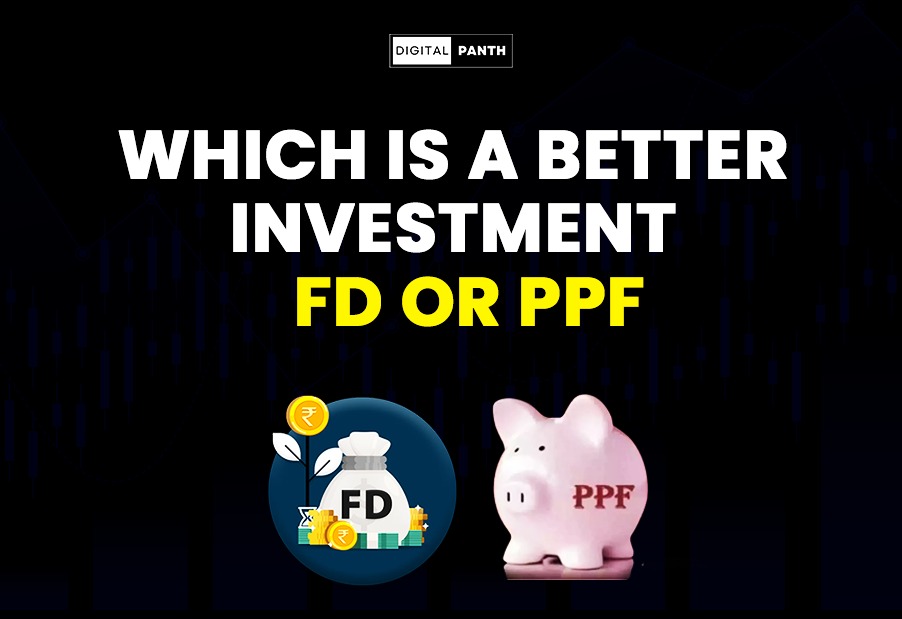Investment in itself is a pillar that makes your future life happy. It increases your funds to achieve your future financial goals. The returns you receive in FD or PPF are guaranteed. Fixed deposit (FD) and public provident fund (PPF) are the best choices for saving and investing, based on your investment requirements. Before making an investment, you should know the differences between these account types, as both have their characteristics.
Fixed Deposit.
A type of investment known as a fixed deposit (FD), which is known as a term deposit, makes the investor securely keep their money in an account and earn good interest. The interest rate for FD is consistently higher than the interest rate for a savings account. The interest rate and deposited amount remain the same in a fixed deposit during the entire term. An FD can be had from any bank, be it a commercial bank, small financial bank, or non-banking financial company.
Main features of Fixed Deposits.
Fixed deposits are a secured investment choice for those seeking a risk-free investment. Fixed deposit investments are known for guaranteed returns. Fixed deposit returns are unaffected by market volatility. In FD investment, long-term periods offer higher returns. However, you should be very careful while investing in fixed deposits, as the trustworthiness of financial institutions is essential; only then you can obtain assured returns.
Features of the FD scheme are:
- Flexible duration: The tenure of FD depends on your investment requirements, you have the option to choose between short-term or long-term fixed deposits. The duration can vary from 7 days to 10 years.
- Assured returns: The interest rates on FDs are not decided based on market conditions. The rate of interest is fixed at the time of investment in the FD, and you receive the same guaranteed returns upon maturity, which have already been fixed.
- Increased profits: There are some FDs where the interest is compounded monthly, quarterly, or semi-annually, known as Cumulative FDs. This type of FD ensures increased returns on the original sum.
- Consistent source of income: There is a type of fixed deposit that offers monthly payments. This type of FD serves as a regular source of income in every month. By investing in this type of fixed deposit scheme, you can make money consistently.
- Optional tenure: The people who invest in FD have the option to select from a range of tenures; the longer you invest, the more return you get. There are a range of options available regarding the tenure of FDs. It is highly flexible. It begins at 7 days and extends to 10 years. Only the tax-saving fixed deposits have a 5-year lock-in period. Investors have the option to select the investment period according to their financial requirements.
- Advantage of Tax-saving: You can avail the benefit of tax-saving by investing in fixed deposits, but that investment should not be less than 5 years. You can avail income tax benefits only on those FDs with a lock-in period of 5 years or more. You are eligible for a tax deduction up to ₹1,50,000 under Section 80C of the Income Tax Act, 1961.
- Advantages for elderly individuals: Many financial institutions provide FDs for senior citizens with high interest rates, which can be more helpful for making good savings.
- Loan against a fixed deposit:
If you have an FD and need some loans urgently, you can take a loan using your FD as collateral. The banks provide loans of 85% to 90% of the fixed deposit amount. If the borrower does not pay back the loan, the banks can retrieve the funds from the fixed deposit amount, which serves as security.
Public Provident Fund (PPF).
The Public Provident Fund (PPF) is a tool for saving taxes, which the government supports. It provides extensive support for people after retirement and sometimes helps in any emergency in a lifetime. PPF is considered entirely secure due to the government’s support.
You have the option to invest in PPF either through your bank or at the post office. The PPF interest rates of the banks may vary from the PPF interest rates of Indian Post Offices.
PPF investment requires investors to keep their money locked in for 15 years. The minimum annual investment amount is ₹ 500, while the maximum is ₹ 1.5 lakh per annum. A tax deduction can be claimed for contributions to PPF under Section 80C of the Income Tax Act, 1961. Returns obtained from the Public Provident Fund (PPF) are not taxable as per the Income Tax Act of 1961.
Main features of the Public Provident Fund Scheme.
Investors who want stable returns over an extended period, may find PPF investments advantageous. Moreover, PPF has a lock-in period of 15 years. Therefore, if an investor is willing to continue investing a portion of their income for 15 years, PPF is a good choice. An individual has the option to extend their PPF account for an additional duration of 5 years at any point in their lifetime.
PPF investments can also help fulfil the financial requirements for children’s education, marriage, owning property, etc. So, if anyone with a regular source of income can opt for this tool for long-term investment, investors can invest in PPF to save money from taxes and receive a tax deduction under Section 80C. Below are a few main features of the Public Provident Fund Scheme:
- Duration: In PPF investment, deposits must be made annually for a 15-year period. The PPF requires a minimum duration of 15 years. If you want, you have the option to renew it for an additional 5 years. PPF requires a commitment of 15 years. Yet, partial withdrawals can be made after six years since the initial investment was made.
- Minimum limit of investment: The lowest and highest deposit limits of the plan are Rs. 500 and Rs. 1.5 lakh, respectively. The Minimum investment limit for PPF is ₹500. The highest possible investment allowed in PPF is ₹1.5 lakhs per year.
- Tax-saving: You can avail tax-saving benefits if you invest in PPF. The amount invested in PPF is deducted from taxable income. There is a maximum limit of ₹1.5 lakhs per year along with all other investments made under Section 80C of the Income Tax Act, 1961.
- Frequency of deposits: If you have to make payment in a PPF scheme, you can deposit money using demand drafts, online fund transfers, cheques, or cash.
- Different options for deposit: If you have to make payment in a PPF scheme, you can deposit money by using demand drafts, online fund transfers, cheques, or cash.
- Nomination: When you start a PPF account, you need to nominate one or more nominees to your account; in case the nominees are more than one person, the account holder has mentioned the percentage of share. The nominee is eligible to collect the money on the death of the PPF account holder.
- Government-supported: Government support is a very important factor in this scheme, limiting its risks. Due to government support, PPF offers a guaranteed return and complete investment protection. The level of risk is extremely low.
- Loan facility: The loan can be taken against the public provident fund starting from the third year of investment up to the sixth year after opening the PPF account. The loan limit is fixed at 25% of the PPF account balance at the end of the 2nd year before the loan application year. The borrowed amount must be reimbursed in a maximum of 36 installments within a 36-month period. You have the option to obtain another loan before the conclusion of the sixth financial year as long as your initial loan has been completely repaid.
Which is better- FD or PPF?
Both better PPF are suitable choices for investors who are not willing to take risks. People seeking to both save taxes and invest for the future prefer PPF. Because of the support from the government, the level of security it offers is unparalleled. Additionally, the appeal of tax-free interest adds to its attractiveness. However, it requires a lengthy lock-in period with restricted withdrawal options starting from the 7th year. In comparison to FDs, they provide lower levels of investment flexibility.
On the other hand, FDs are more liquid in comparison and offer flexibility in choosing the duration. Tax-saving Fixed Deposits have a shorter lock-in period of 5 years compared to the longer lock-in period of the Public Provident Fund (PPF). However, carrying FDs involves some risk and the interest you receive is subject to taxation.
If you are comfortable with a 15-year commitment, PPF could be a better choice considering all factors. However, FD is a better choice if you want a short-term investment.
Conclusion.
Determining whether a fixed deposit (FD) or a public provident fund (PPF) is the superior option can pose a challenge because the correct decision will vary depending on the individual’s financial circumstances and objectives. Fixed Deposits (FDs) and Public Provident Funds (PPFs) are options for saving and investing that can earn interest and offer tax advantages. Fixed deposits are commonly provided by banks and other financial institutions, with a consistent interest rate given for a specific duration. PPFs, in contrast, are investment plans supported by the government that individuals can access. They provide a fluctuating interest rate determined by the Indian government.
FAQs.
Indeed, the duration of a PPF account can be prolonged in periods of 5 years.
If you are okay with committing to a 15-year, PPF might be a wise choice.



Leave feedback about this